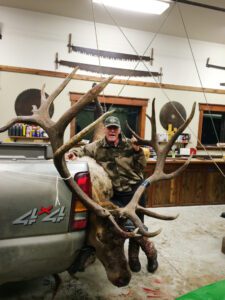By Joseph T. O’Connor Explore Big Sky Managing Editor
Thirteen minutes remained in the 2014 hunting season on Nov. 30, just enough time for Big Sky local Jim Schwalbe to tag the biggest bull elk of his life in southwestern Montana.
It took him the entire season to find the bull he was waiting for – one bigger than the six-by-seven-point he has hanging in Choppers Grub and Pub in Big Sky. Through binoculars and a spotting scope, Schwalbe had glassed elk for 10 days before going out on the hunt. The morning of closing day it was -10 F when he and his hunting partner Shad Boardman went out on horseback.
After post-holing in the morning though knee-deep snow, he caught up to Boardman, who was bundled up and had started a fire. “I was in a T-shirt, sweating [from that hike],” says Schwalbe, 61, who later in the afternoon trudged up a steep ridge and set up behind a waist-high snowdrift.
At 5 p.m., Schwalbe spotted a six-point bull elk near him, but it took off when it caught wind of him. He ran after the bull and came across it again when it joined a group of three others. And then he got it – the one he’d been waiting for, an eight-by-eight behemoth.
“I picked up his head and said, ‘Woah. This is a nice bull,’” says Schwalbe, a 41-year Big Sky resident originally from Pewaukee, Wis.
Bull elk antlers are classified as typical – essentially symmetrical – and non-typical, meaning they have tines or points growing in different places causing the antlers to look different from each other.
The unofficial score put Schwalbe’s elk’s antlers at 444 points, which would have surpassed the Montana state record for American non-typical elk of 429 1/8, according to the Boone and Crockett Club scoring system that equates points with inches. But the official scorer, Fred King of Gallatin Gateway, took it down a few inches because of tine imperfections.
“When it comes down to the official measurement, things change,” said King, who’s been an official scorer for the Boone and Crockett as well as Pope and Young clubs since 1984. King used 25 different measurements to come up with the total score.
The gross “green” score – which is the official score until the antlers have dried for 60 days after the kill – put Schwalbe’s elk at 423 7/8, but after differences in symmetry were subtracted from the main frame, and when 14 4/8 inches for non-typical points were added back into the total, King scored it at 396 6/8.
and when 14 4/8 inches for non-typical points were added back into the total, King scored it at 396 6/8.
If the score holds, it will be ranked as the 110th in the world, King said. “That sounds like a long ways down,” he added. “But the thing I’ve learned over [the] years is any time you get a trophy – even if you get a trophy that approaches book minimum – that’s an outstanding animal.”
The minimum score for a bull elk to be recorded into the Boone and Crockett “book” in the non-typical category is 385.
Schwalbe says that while he was a little disappointed his elk wasn’t the state record he wasn’t surprised. He guessed 397 points before anyone scored it.
“He’s probably the nicest bull I’ve ever seen,” Schwalbe said. “My hunter friends were so supportive and that’s what kept me going all season. They knew I didn’t want to shoot anything small.”
Montana’s Rocky Mountain elk tend to not grow as large as those in Nevada, Arizona, New Mexico or Colorado – record animals often come from the Southwest – because of harsher winters, more predation and greater hunting pressure, Schwalbe said.
“There is potential for elk in Montana to grow that large, but because of these factors, they don’t tend to see that potential,” King noted, pointing to a number of factors that contributed to this particular elk growing a rack that large in southwest Montana.
“What this bull represents is more than just a trophy,” said King, who retired from Montana’s Fish, Wildlife and Parks five years ago, and has also been a Hunter Education Instructor since 1975. “The [factors] are a combination of food, shelter, water, migration routes, ranges, and age – this animal is a survivor and had a chance to grow a fine set of antlers.”
At approximately 800 pounds live-weight, Schwalbe says this elk may not have lasted the winter. “He was probably about 12 years old,” he said.
Wild elk in Montana don’t tend to live much longer than that on average, according to King. “If they’re on good range and in good health, for bulls – because of their lifestyle – 10-15 [years] tops would be about it,” he said, adding that quality elk habitat is also quality human habitat.
King wrote chapter two in the Boone and Crockett Club book called, “Measuring and Scoring North American Big Game Trophies,” published in 2009.
“There is more to a trophy animal than just the size of antlers, horns, or body,” King wrote. “To a hunter, a large part of the quality of any trophy does not necessarily show up in the final mathematical score. The unmeasured quality is the enjoyment of being out during the hunting season in the habitat and space that produced the animal.”
And what a space it is.
—-
The original article, published in the Dec. 12 issue of the Explore Big Sky newspaper, stated that if these antlers are officially scored at 396 6/8, they would be ranked 110th in the world. The correct ranking is 163rd.













